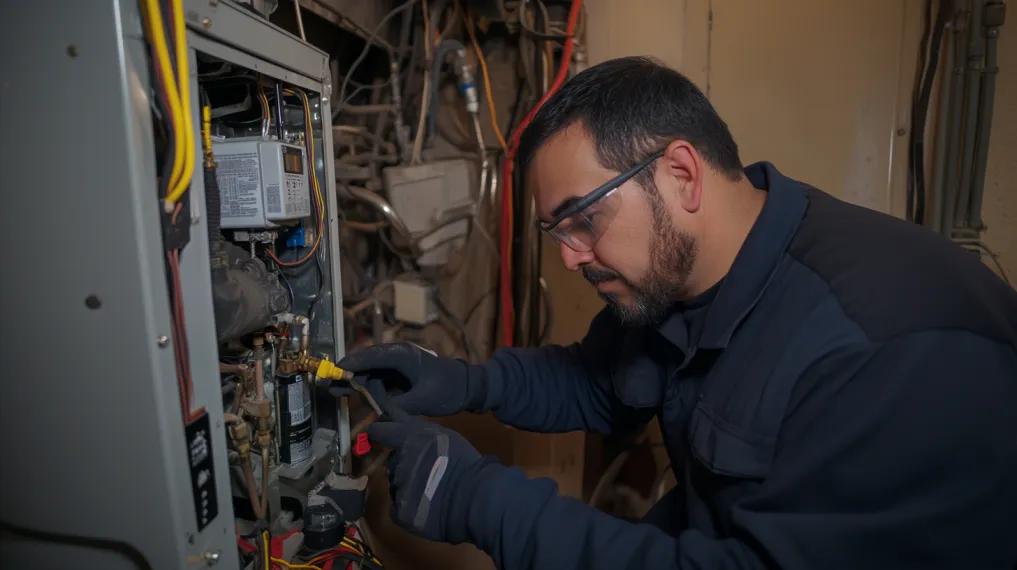How Does a Gas Furnace Work?

Let’s be honest – most of us don’t spend much time thinking about our furnace. It sits quietly in the basement or utility room, out of sight and out of mind, until the first cold snap hits. As long as it’s working properly, we go about our day without a second thought, unaware of the complex process happening to keep us comfortable. But have you ever thought to yourself, “How does a gas furnace work?”
If you’re curious about how your furnace helps you maintain a cozy home throughout the winter months, HVAC.com is here to help! We break down the heating process to help you understand how gas furnaces work.
Key Components of a Gas Furnace
Natural gas furnaces have several components that all work together to generate and distribute heat throughout your home. Here’s a look at some of the primary components of a gas furnace:
Thermostat
The thermostat is the control center for your heating system. It detects the temperature in your home and sends signals to the furnace to start or stop heating.
Gas Valve
The gas valve controls the flow of gas to the burner. It opens and closes based on the furnace’s needs and is regulated by the thermostat’s signals.
Ignition System
Modern gas furnaces use either an electronic ignition system or a pilot light to ignite the gas. The electronic ignition system generates a spark or uses a hot surface igniter to start the combustion process.
Burner
The burner mixes gas with air. This mixture is then ignited by the ignition system, creating a flame that generates heat.
Heat Exchanger
The heat exchanger transfers heat from the combustion process to the air that circulates through your home. It absorbs heat from the burning gas and transfers it to the air flowing over it.
Blower Fan
The blower fan is responsible for moving air over the heat exchanger and then distributing the warmed air throughout your home via your air ducts.
Flue or Vent Pipe
The flue or vent pipe vents the byproducts of combustion, such as carbon monoxide and other gasses, out of your home. Proper ventilation ensures that these harmful gasses don’t accumulate inside your home to keep your family safe and healthy.
How Do Natural Gas Furnaces Work?
Here’s a step-by-step look at how gas heaters work:
1. Thermostat Activation
The heating cycle begins when your thermostat senses that the temperature in your home has dropped below the desired level. It sends a signal to the furnace to start heating.
2. Ignition Sequence
Once the furnace receives the signal from the thermostat, the ignition sequence begins. If your furnace uses an electronic ignition system, it generates a spark or activates a hot surface igniter to light the gas in the burner. For older models with a pilot light, the gas is ignited by the existing flame.
3. Gas Combustion
Natural gas burns in the furnace’s combustion chamber. The combustion process generates heat that is used to warm the air.
4. Heat Exchange
Hot gasses produced from the combustion process pass through the heat exchanger. The heat exchanger’s metal body absorbs heat from the gasses and transfers it to the air circulating inside the furnace.
5. Air Circulation
The blower fan then pushes the heated air through the ductwork and into the various rooms of your home.
6. Ventilation
As the gas burns, it produces combustion byproducts, including carbon monoxide. These gasses are vented outside through the flue or vent pipe to prevent them from accumulating inside your home.
7. Temperature Regulation
Once the thermostat detects that the desired temperature has been reached, it signals the furnace to stop heating. The furnace will then remain in standby mode until the temperature drops again.
8. The Heating Cycle Repeats
When the temperature in your home falls below the thermostat setting again, the entire heating cycle starts over. The thermostat sends a signal to the furnace, initiating the ignition sequence to resume the heating process which keeps your home warm and comfortable.